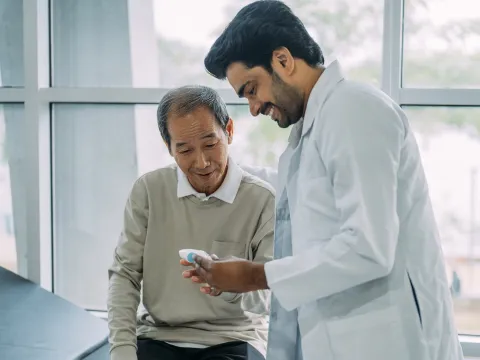- AdventHealth

Choose the health content that’s right for you, and get it delivered right in your inbox.
Affecting about 3% of children under the age of 16, scoliosis is the most common spine condition in young people. Scoliosis is a sideways curvature of the spine that most often occurs during a child’s growth spurt, just before puberty.
It’s a common misconception that heavy backpacks, lack of exercise and slouching contribute to this spine condition.
Most cases are what doctors call idiopathic, which means they don't know what the cause is. In other words, parents shouldn’t blame themselves if their child has scoliosis, as there is no known way to prevent the disorder.
However, there does appear to be a genetic component involved. So, if your child has scoliosis, their siblings may be more likely to have it, too.
Raymund Woo, MD, AdventHealth for Children Medical Director of Pediatric Orthopedic Surgery, shares more on the symptoms and treatment options for kids living with scoliosis so you can help your child minimize any mental or physical effects of a scoliosis diagnosis.
Are there different types of scoliosis in children?
There are a few different types of scoliosis found in children.
- Idiopathic scoliosis is considered the most common type of scoliosis in children between the ages of 10 to 18, according to the Scoliosis Research Society.
- Early-onset scoliosis affects children under the age of 10 and is normally a type of idiopathic scoliosis.
- Congenital scoliosis happens when a baby's vertebrae do not form correctly, causing scoliosis to develop while still in the mother's womb.
- Neuromuscular scoliosis occurs if a child has a condition that negatively impacts the nervous and muscular systems of the body, such as cerebral palsy or spina bifida.
- Syndromic scoliosis arises in children who have certain syndromes that can cause scoliosis, including Down syndrome, Marfan syndrome, and Prader-Willi.
What causes scoliosis in kids and teens?
It is still unclear as to what causes scoliosis in children, however, past research has identified certain factors that may cause scoliosis such as:
- Genetics: Children with a family history of scoliosis are at a greater risk of developing the condition.
- Hormones: Past studies show that abnormal levels of certain hormones may be linked to scoliosis in adolescents.
- Nutrition: If a child's diet is low in vitamin D and calcium, they may be at a higher risk of developing scoliosis.
- Sun Exposure: The body needs sunlight to make vitamin D — too little sun exposure may decrease a child's vitamin D level and increase their risk of scoliosis.
- Diseases: Certain conditions can cause scoliosis such as cerebral palsy and Down syndrome.
- Trauma: Injury to the spine can cause scoliosis in children.
What are the common symptoms of scoliosis parents should watch for?
Most cases of scoliosis don’t have any symptoms at all. Much like children with slight hearing or vision changes, early cases can be missed. Your pediatrician and school nurse should perform scoliosis screening as part of their annual wellness visit.
But some issues that could be possible symptoms of scoliosis in children include:
- uneven shoulders — if your child bends forward, their shoulders should be in line with each other if they do not have scoliosis
- uneven shoulder blades
- one hip is higher than the other
- one arm is longer than the other when the child stands up straight
- head is not centered over the body
- obvious curve or lopsided look to the back when a child bends forward
- uneven skin folds at the waist
- rib cage and/or muscles sticking out on one side
- child looks like they are leaning to one side
- properly-sized clothing does not fit correctly
How young can a child show symptoms or be diagnosed?
Most cases of scoliosis are diagnosed after age 10, when the child is in 4th or 5th grade. However, there are cases of scoliosis seen in younger children and even infants. Many of these cases have no symptoms, but children can have problems with back pain, neck pain, headaches, leg weakness, and changes in their bowel or bladder habits.
Are children still screened for scoliosis by schools or only their pediatrician?
School screening varies widely. Private schools may not incorporate this as part of their normal school nurse program. Public schools can have a school screening policy if it is approved by their county school board. However, scoliosis screening is part of every child’s regular yearly checkup with their pediatrician.
How important is it to detect scoliosis early, and how can early detection benefit kids?
Early detection and treatment are the keys to treating scoliosis because they can prevent the need for spinal fusion surgery. If detected early, scoliosis can be treated by therapy or bracing. In particular, bracing has been proven to work in 85% of patients with mild scoliosis.
What may happen if it is not caught early?
Scoliosis worsens as the child grows, so the faster the child grows, the faster the curve will worsen. If their curve is severe, your child will need surgery to have their spine fused. The goal is to catch scoliosis when it’s mild and avoid surgery through early intervention.
What are short-term and long-term treatment options?
Treatment is divided into three categories: bracing, observation and surgery.
Bracing is the most important component of short-term treatment. It works best on children who haven’t gone through puberty and is not useful after the child is skeletally mature. Generally, this is around age 14 for girls and age 16 for boys.
Observation is used for children who have a scoliosis curve that is too small for bracing, and older children who are not growing quickly. Most cases of scoliosis are treated with observation with a visit to the orthopedic surgeon for spine X-rays every six months.
Surgery, while uncommon, is the only way to treat curves that are too large for bracing. There are many surgical options and new techniques which can be discussed with the orthopedic surgeon. AdventHealth for Children can now provide radiation-free surgery in reduced time using a 7D Surgical FLASH ™ Navigation System.
We are the first and only pediatric hospital in the state of Florida to help children heal faster with this new and innovative technology. It is the first and only platform that utilizes Machine-Vision Image Guided Surgery (MvIGS) technology, meaning spine surgeons can guide their tools to the area needing treatment using a camera that’s linked to a computer in the operating room.
The new technology is similar to what is used in the latest self-driving cars. Unlike time-consuming, conventional image-guided surgery, this new tool can help achieve:
- Efficient surgery for spine procedures
- Elimination of unnecessary radiation exposure
- Reduced operative time for patients
What are the main differences between scoliosis treatment for toddlers vs adolescents?
As a child's body — including their spine — is still growing, the type of treatment they receive will be based on their age and how severe their scoliosis case is.
For example, mild scoliosis in a child at any age may need no treatment and just monitoring as the spine will correct itself as the child grows.
In babies, toddlers, and children under the age of 10, moderate cases of scoliosis may be treated through bracing or casting. Both these methods are designed to help prevent the spine from curving further as the child grows.
Adolescents can also be treated through bracing and/or physical surgery. Spinal fusion surgery for scoliosis in children is generally only considered in ages 10 and up for the most severe cases.
If a child under 10 years of age requires surgery, their surgeon would place a metal growing rod implant, which is affixed to the spine, to help correct its curve as the child grows.
Can a child fully recover from scoliosis?
Scoliosis is not a reversible disease, hence the need for early detection and treatment. Surgery is the only way to fully correct scoliosis but comes with risks and long-term effects. However, there is lots of long-term research showing that children who have spinal surgery have very good results at 45 years after their surgery.
More Information for Parents
There’s a lot of information on the internet about scoliosis — but as with anything else, parents should turn to their pediatrician or family physician for the most up-to-date facts and guidance. Dr. Woo recommends discussing any concerns you have with a qualified pediatric orthopedic spine surgeon. We’re always here for your family’s whole health.



